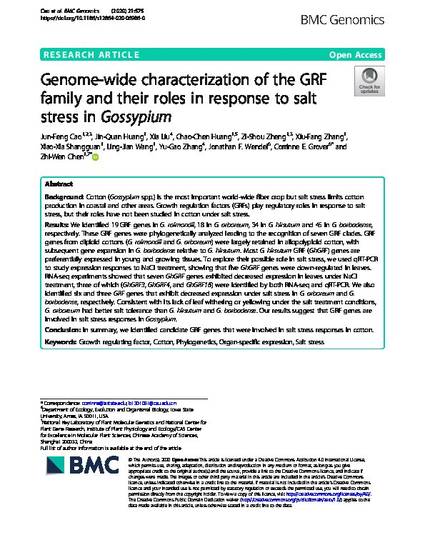
Background: Cotton (Gossypium spp.) is the most important world-wide fiber crop but salt stress limits cotton production in coastal and other areas. Growth regulation factors (GRFs) play regulatory roles in response to salt stress, but their roles have not been studied in cotton under salt stress.
Results: We identified 19 GRF genes in G. raimondii, 18 in G. arboreum, 34 in G. hirsutum and 45 in G. barbadense, respectively. These GRF genes were phylogenetically analyzed leading to the recognition of seven GRF clades. GRF genes from diploid cottons (G. raimondii and G. arboreum) were largely retained in allopolyploid cotton, with subsequent gene expansion in G. barbadense relative to G. hirsutum. Most G. hirsutum GRF (GhGRF) genes are preferentially expressed in young and growing tissues. To explore their possible role in salt stress, we used qRT-PCR to study expression responses to NaCl treatment, showing that five GhGRF genes were down-regulated in leaves. RNA-seq experiments showed that seven GhGRF genes exhibited decreased expression in leaves under NaCl treatment, three of which (GhGRF3, GhGRF4, and GhGRF16) were identified by both RNA-seq and qRT-PCR. We also identified six and three GRF genes that exhibit decreased expression under salt stress in G. arboreum and G. barbadense, respectively. Consistent with its lack of leaf withering or yellowing under the salt treatment conditions, G. arboreum had better salt tolerance than G. hirsutum and G. barbadense. Our results suggest that GRF genes are involved in salt stress responses in Gossypium.
Conclusion: In summary, we identified candidate GRF genes that were involved in salt stress responses in cotton.
Available at: http://works.bepress.com/jonathan_wendel/96/

This article is published as Cao, J., Huang, J., Liu, X. et al. Genome-wide characterization of the GRF family and their roles in response to salt stress in Gossypium. BMC Genomics 21, 575 (2020). doi: 10.1186/s12864-020-06986-0.